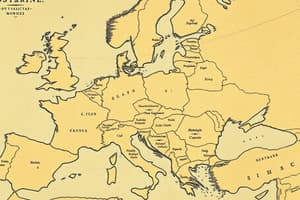Podcast
Questions and Answers
In Renaissance Europe, the social hierarchy was based on feudalism.
In Renaissance Europe, the social hierarchy was based on feudalism.
False (B)
The Catholic Church was polytheistic and practiced human sacrifice.
The Catholic Church was polytheistic and practiced human sacrifice.
False (B)
In Edo Period Japan, the social hierarchy was based on a tripartite system consisting of nobles, commoners, and slaves.
In Edo Period Japan, the social hierarchy was based on a tripartite system consisting of nobles, commoners, and slaves.
False (B)
The Aztecs believed in a strict hierarchy of bishops, priests, and monks, with the Pope at the top.
The Aztecs believed in a strict hierarchy of bishops, priests, and monks, with the Pope at the top.
Medieval Europe had a more fluid social hierarchy than Renaissance Europe.
Medieval Europe had a more fluid social hierarchy than Renaissance Europe.
The Shogunate was a feudal military government that ruled Europe from 1603 to 1868.
The Shogunate was a feudal military government that ruled Europe from 1603 to 1868.
The Black Death led to the rise of nation-states in Medieval Europe.
The Black Death led to the rise of nation-states in Medieval Europe.
All these societies had a completely egalitarian social structure.
All these societies had a completely egalitarian social structure.
In Medieval Europe, the feudal system was based on the belief that monarchs were appointed by God and held absolute power.
In Medieval Europe, the feudal system was based on the belief that monarchs were appointed by God and held absolute power.
The Catholic Church in Renaissance Europe emphasized individualism and classical Greek and Roman culture.
The Catholic Church in Renaissance Europe emphasized individualism and classical Greek and Roman culture.
The Aztecs believed in the concept of original sin and salvation.
The Aztecs believed in the concept of original sin and salvation.
In Edo Period Japan, the shogunate was a feudal military government that ruled from 1066 to 1200.
In Edo Period Japan, the shogunate was a feudal military government that ruled from 1066 to 1200.
The social hierarchy of the Catholic Church was based on a tripartite system of nobles, commoners, and slaves.
The social hierarchy of the Catholic Church was based on a tripartite system of nobles, commoners, and slaves.
The samurai code in Edo Period Japan emphasized social mobility and upward mobility through education and trade.
The samurai code in Edo Period Japan emphasized social mobility and upward mobility through education and trade.
Humanism in Renaissance Europe emphasized the importance of the Papal authority.
Humanism in Renaissance Europe emphasized the importance of the Papal authority.
The feudal system in Medieval Europe and the shogunate in Edo Period Japan were similar in that they were both based on a system of human sacrifice.
The feudal system in Medieval Europe and the shogunate in Edo Period Japan were similar in that they were both based on a system of human sacrifice.
Study Notes
Medieval Europe
- Social hierarchy based on feudalism: lords owned land, vassals provided military service in exchange for protection and land
- Belief in Divine Right of Kings: monarchs were appointed by God and held absolute power
- Catholic Church played a significant role in shaping social norms and morality
Renaissance Europe
- Humanism emphasized individualism, reason, and classical Greek and Roman culture
- Rise of nationalism: emergence of nation-states and concept of national identity
- Social mobility: emergence of a middle class and possibility of upward social mobility through education and trade
The Catholic Church
- Papal authority: belief in the Pope's infallibility and supreme authority in spiritual matters
- Clerical hierarchy: strict hierarchy of bishops, priests, and monks, with the Pope at the top
- Original sin and salvation: humanity was born sinful, needed salvation through the Church
The Aztecs
- Polytheism: worship of multiple gods and goddesses, each associated with different aspects of life and nature
- Human sacrifice: practice of sacrificing humans to appease gods and maintain balance of universe
- Tripartite system: social hierarchy consisting of nobles, commoners, and slaves
Edo Period Japan
- Confucianism emphasized social hierarchy, respect for authority, and moral values
- Shogunate: feudal military government that ruled Japan from 1603 to 1868
- Samurai code: set of principles and ethics governing behavior of samurai warriors
Similarities and Differences
- Similarities:
- Hierarchical social structure
- Significant role of religion in shaping social norms and values
- Concentration of power and authority in the hands of a few elites
- Differences:
- Medieval Europe: feudalism, feudal lords, and Catholic Church influence
- Renaissance Europe: emergence of middle class, humanism, and nationalism
- Catholic Church: strict hierarchical structure, papal authority, and emphasis on salvation
- Aztecs: polytheism, human sacrifice, and tripartite social hierarchy
- Edo Period Japan: Confucianism, feudal military government, and samurai code
Studying That Suits You
Use AI to generate personalized quizzes and flashcards to suit your learning preferences.
Description
Explore the social hierarchies and world views of Medieval Europe, Renaissance Europe, the Catholic Church, the Aztecs, and Edo Period Japan. Understand the beliefs and ideas that shaped these societies.




